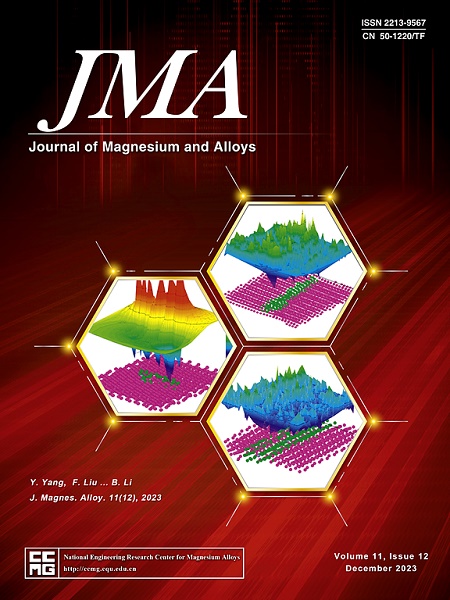Enhancing comigration-ability of Mg2Sn particles with Mg matrix via interphase segregation of Zn
IF 13.8
1区 材料科学
Q1 METALLURGY & METALLURGICAL ENGINEERING
引用次数: 0
Abstract
This study investigates the impact of Zn alloying on the dispersion of the reinforcing particle in Mg2Sn/Mg composites. In the composite, Zn manifests in three distinct forms: Zn segregation layer between Mg![]() Mg2Sn, the solid solution and the MgZn2 phase. First-principles calculations confirm that the formation of Zn segregation layer decreases the interfacial energy of the Mg
Mg2Sn, the solid solution and the MgZn2 phase. First-principles calculations confirm that the formation of Zn segregation layer decreases the interfacial energy of the Mg![]() Mg2Sn. Importantly, this segregation layer significantly enhances the comigration capability of Mg2Sn particles with Mg matrix during sintering flow, effectively hindering the agglomeration and coarsening of the nano-sized reinforcing phase. The dense and uniformly distributed nano-sized Mg2Sn significantly increases the activity of non-basal slip, ensuring good elongation of the composite while enhancing strength. It can be concluded that enhancing the comigration-ability of reinforcing particles with the matrix is an effective strategy for achieving controlled dispersion of high-volume reinforcing particles and an excellent combination of strength and ductility in magnesium matrix composites.
Mg2Sn. Importantly, this segregation layer significantly enhances the comigration capability of Mg2Sn particles with Mg matrix during sintering flow, effectively hindering the agglomeration and coarsening of the nano-sized reinforcing phase. The dense and uniformly distributed nano-sized Mg2Sn significantly increases the activity of non-basal slip, ensuring good elongation of the composite while enhancing strength. It can be concluded that enhancing the comigration-ability of reinforcing particles with the matrix is an effective strategy for achieving controlled dispersion of high-volume reinforcing particles and an excellent combination of strength and ductility in magnesium matrix composites.

通过锌的相间偏析提高 Mg2Sn 颗粒与镁基体的结合力
本文研究了锌合金化对Mg2Sn/Mg复合材料中增强颗粒分散的影响。在复合材料中,Zn以三种不同的形式存在:MgMg2Sn之间的Zn偏析层、固溶体和MgZn2相。第一性原理计算证实,锌偏析层的形成降低了MgMg2Sn的界面能。重要的是,该偏析层显著增强了Mg2Sn颗粒在烧结过程中与Mg基体的团聚能力,有效地阻碍了纳米级增强相的团聚和粗化。致密且分布均匀的纳米Mg2Sn显著提高了非基滑移活性,在提高强度的同时保证了复合材料的良好伸长率。综上所述,增强增强颗粒与基体的共混能力是镁基复合材料中实现大体积增强颗粒可控分散和强度与塑性良好结合的有效策略。
本文章由计算机程序翻译,如有差异,请以英文原文为准。
求助全文
约1分钟内获得全文
求助全文
来源期刊

Journal of Magnesium and Alloys
Engineering-Mechanics of Materials
CiteScore
20.20
自引率
14.80%
发文量
52
审稿时长
59 days
期刊介绍:
The Journal of Magnesium and Alloys serves as a global platform for both theoretical and experimental studies in magnesium science and engineering. It welcomes submissions investigating various scientific and engineering factors impacting the metallurgy, processing, microstructure, properties, and applications of magnesium and alloys. The journal covers all aspects of magnesium and alloy research, including raw materials, alloy casting, extrusion and deformation, corrosion and surface treatment, joining and machining, simulation and modeling, microstructure evolution and mechanical properties, new alloy development, magnesium-based composites, bio-materials and energy materials, applications, and recycling.
 求助内容:
求助内容: 应助结果提醒方式:
应助结果提醒方式:


